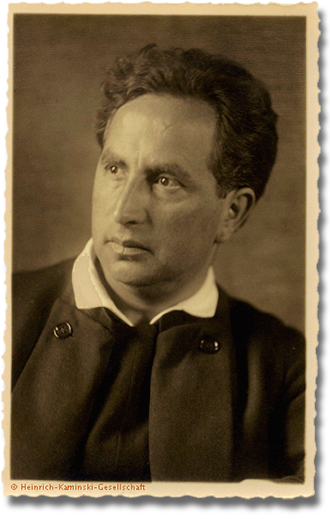2023
2022
2021
2020
2019
2018
2017
2016
2015
2014
2013
2012
2011
2010
2009
2008
2006
2005
2004
2003
2002
1994
1946
1945
1944
1943
1942
1941
1940
1939
1938
1937
1936
1935
1934
1933
1932
1931
1930
1929
1928
1927
1926
1925
1924
1923
1922
1921
1920
1919
1918
1917
1916
1915
1914
1913
1912
1911
1909
1908
1907
1906
1905
1903
1898
1892
1886

Heinrich Kaminski
Heinrich Kaminski was born on July 3, 1886 in Tiengen, located along the upper Rhine. His mother Mathilde Barro originated from Heidelberg and was an opera singer. His father Paul had been a Catholic priest before leaving his Polish home after Vatican Council I in 1869-1870. He later became a minister in the Old Catholic Church.Heinrich Kaminski was accepted at a boarding school run by the Old Catholic Church in Bonn, from which he graduated in 1905. As he was not interested in studying theology and not having the funds to pursue any other studies, he began an apprenticeship at a bank. In 1906 he received financial help from a local businessman, the owner of the Lauffenmühle, and studied national economics at the University of Heidelberg.
His early years
In 1907 Martha Warburg, a wealthy patron of the arts in Hamburg, became aware of his musical talent and sponsored him. Under Martha Elspermann (piano) and Philipp Wolfram (theory) he made excellent progress and was able to enrol at the Berlin Stern Conservatory of Music in 1909. His instructors there were Severin Eisenberger (piano), Willhelm Klatte (theory) and Paul Juon (composition).In 1912 he composed his unforgettable 130th Psalm for choir and soprano solo. A clarinet and string quartet, also from this time, proved to be much more than mere examples of young talent.
After a short stay in Munich, Kaminski discovered almost ideal working conditions in the Upper Bavarian town of Ried (Benediktbeurern) in the spring of 1914. It was here that he completed, only a few days after the outbreak of World War I, the 69th Psalm, which was performed for the first time in Munich by Bruno Walter in 1919. At the 51st Tonkünstlerfest (composers festival ) in Nürnberg in 1921 his work was celebrated as a long awaited masterpiece.
In 1916 he married Elfriede Jopp, a singer in one of his choirs in Munich. In the same year he completed the impressive string quintet in F sharp minor. After its premiere in March 1917 it was acclaimed as the revelation of a genius by the Münchner Neuesten Nachrichten newspaper.
Years of Mastery
Franz von Hoeßlin, the composer Walter Braunfels, Maria Marc, the painter Franz Marcs widow as well as the painter Emil Nolde helped to support the growing family after the end of the War. Maria Marc took the family into her home in Ried. From 1922 on Werner Reinhart, a successful merchant from Winterthur, became a good friend and generous benefactor for Kaminski.In addition to working as a composer in Ried, he also had several students, of whom Erich Doflein, Carl Orff and Reinhard Schwarz-Schilling are especially worth mentioning.
The works Kaminski produced after 1918 soon became imperative for the musical world at that time: Introitus and Hymnus, the music to a passion play in Old French, the Concerto grosso for a double orchester, the Magnificat and the motet Der Mensch.
After a struggle of many years, Kaminski attempted to restore the musical theatre by completing his drama Jürg Jenatsch in 1929. The first performance with Fritz Busch, however, attracted only a mixed response.
In 1930 Kaminski was given a professorship and taught a master class at the Prussian Academy of Arts in Berlin. His appointment as musical director in Bielefeld followed the same year.
His motet Die Erde, as well as Triptychon for alto and organ, the string quartet under the title of A-B-E-G-G and Music for Two Violins and Cembalo all originated from this time. At the beginning of 1934 Hermann Scherchen staged Dorische Music for Orchestras in Winterthur. It soon represented a climax in contemporary music.
In 1933 Kaminskis teaching contract in Berlin was not renewed. In Bielefeld too, the new regime sought to bring musical life into line. In September 1933, Kaminski chose to no longer participate in symphony concerts. In June 1934, he was forced to give up his position as director of the Musikverein. Influenced by events leading to the Röhm uprising in 1934, he composed Messe Deutsch. Although fragmentary, it was a testimony to his inner opposition.
The practical experience he gained in Bielefeld was very useful: Kaminski employed compositional techniques more sparingly. This was beneficial to both his Orchesterwerk mit Klavier completed in 1936 and the orchestrated Tanzdrama from 1942. In 1937 performances of Kaminskis music were banned in Germany. His works were only performed in Switzerland.
After his family moved to Munich, Kaminskis life became even more restless. He was often received by Helene Princess Croy in Habichen, Tirol and in other towns in Switzerland.
Shortly after the outbreak of World War II, his oldest daughter Gabriele died. He tried to overcome this tragic stroke of fate by composing the very moving In memoriam Gabrielae.
Inner Emigration
After 1942 Kaminski began working on the musical drama Das Spiel von König Aphelius, its completion delayed by a serious illness. More and more his battle with death found expression in his works.In March 1943 Alexander Schmorell, a member of the White Rose, sought and was given refuge by Kaminski. His son Donatus was killed in the war, his daughter Bettina died in 1944. A frenzied bout of creativity allowed him to complete his last work Das Spiel vom König Aphelius on March 22, 1946.
Heinrich Kaminski died on June 21, 1946 in Ried.
Translated by Cornelia Benedix